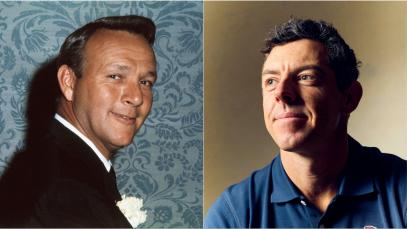PGA Tour players tend to move in packs. Once one player starts doing something a little differently, the peers will take notice. Once that player starts playing well, suddenly you'll start seeing their methods pop up anyway.
Alignment sticks are hardly anything new on the PGA Tour, which is something amateur golfers should take note of. You can't walk more than a few feet on a tour driving range without seeing a player practicing with at least one. At an amateur driving range, you'd be lucky if you found one at all.
Traditionally, players set an alignment stick alongside a player's toes, which should run parallel to the target line. Line up your toes against the stick, and you'll prevent a stance that's too open or closed.
But recently, I've noticed those alignment rods on tour getting further from the feet, and closer to the golf ball. At times, the alignment rod is almost flush against the clubhead as they're hitting the ball itself.
There are two reasons for this.

1. Aim the clubface
The first, and most obvious, is because it helps aim the clubface.
Where your feet are pointing matters, obviously, but the direction the clubface is pointing at impact is the primary factor in where the golf ball is going to go. AKA, if the clubface is pointing to the left, the ball will probably go left.
Placing an alignment stick, or a club, flush with the clubhead, helps pros check and make sure their clubface is pointing in their intended direction. Both the stick and the clubface should be pointing at their intended target.
"I hit draws, and my tendency is to aim too far to the right, and start hitting big draws," Eric Cole explains. "I focus a lot on my aim. It's a simple thing that helps me hit better shots."
2. Obstruct a severe swing direction
Outside of simple clubface awareness, players use an alignment stick on the ground, near the golf ball, to monitor their golf swing's direction.
If golfers tend to swing too far in-to-out, they'll place the alignment stick slightly inside the golf ball. If they tend to swing too far out-to-in, or over-the-top, they'll put the stick, or club, slightly outside the golf ball.
In both cases, the goal is simple: To swing so you miss the stick, which means your swing path is landing in a relatively neutral spot.
As pros explain:
"I've always responded really well to using obstacles, and forcing my body to figure out how to swing around them," Justin Thomas said.
Ryan Palmer adds:
"Every time I go and practice, I practice with a purpose. When I go to the range...I'll make sure I'm going there with the drive and desire to work. If I don't feel like I'm ready to practice and I'm just kind of tired or my mind is thinking of something else, I'll go home. I don't go practice or hit balls because I feel like I have to," Palmer says. "This is a small thing that helps me do that."


.jpg.rend.hgtvcom.406.271.suffix/1704304024249.jpeg)
